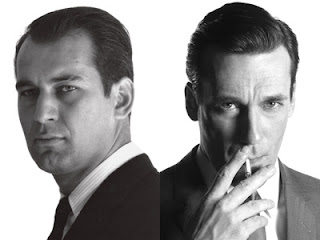George Lois and his Advertising Revolution
Ad pioneer says ‘Mad Men’ doesn't capture '60s spirit
Millions got their long-awaited “Mad Men” fix Sunday night with the return of AMC’s wildly popular drama chronicling the goings-on at Sterling Cooper Draper Pryce.
But George Lois, the legendary ad man and art director some call the real Don Draper — not to his face, trust me — couldn’t care less.
The show turns what was an amazingly creative and courageous time in his business into a perverse fiction of bums and skirt -chasers, says Lois.
In the 1960s, his 92 famous Esquire magazine covers captured the country’s unsettled vibe like lightning in a bottle,addressing subjects ranging from shifting gender roles to Truman Capote’s Black and White Ball, the My Lai Massacre and racial politics.
At 80, Lois is still going strong. He works with his son, Luke, on campaigns, plays basketball at the Y and has just published his 10th book, “Damn Good Advice (for people with talent!),” (Phaidon, $9.95, phaidon.com).
It’s a guide for unleashing one’s creative potential, based on Lois’ experiences as the O.G. of ’60s advertising and the creative genius behind hundreds of memorable campaigns, including work for MTV, ESPN and Tommy Hilfiger.
At his art director's dream of a Greenwich Village apartment, I interviewed Lois about the ’60s, “Mad Men” and whether there are any Big Ideas left.
In your new book, you talk about the importance of the Big Idea. What was advertising’s Big Idea in the ’60s?
By 1964, the time when “Mad Men” takes place, there was a full-blown creative revolution. It started with Bill Bernbach at Doyle Dane Bernbach. Bill hired me. Then I left DDB and started my own creative agency with Fred Papert and Julian Koenig. The creative guys ran everything. The money guys didn’t run it. The account guys didn’t run it. There ended up being six or seven agencies that were run by the creatives.
They did bright, sharp stuff. It was witty.
For the first time, people watched commercials and talked about them the next day at work.
So I’d have to say that the creative revolution was the Big Idea in advertising in the ’60s.
How accurately do you think “Mad Men” reflects the advertising business in the ’60s?
Esquire March 1965
 There are a lot of ads today that are considered “visual pollution”. They lack in essence and there are some that are just too direct, that in the faintest engagement it’ll detonate like an atomic bomb causing an explosive chaos of color and scheme. The days of modernist- influenced ads have passed, where “direct”, “straightforward”, and “simple” meant differently from today’s definition.
There are a lot of ads today that are considered “visual pollution”. They lack in essence and there are some that are just too direct, that in the faintest engagement it’ll detonate like an atomic bomb causing an explosive chaos of color and scheme. The days of modernist- influenced ads have passed, where “direct”, “straightforward”, and “simple” meant differently from today’s definition.
Advertising before the digital age was very different. There was a lot of experimentation, addition, and subtraction of design elements. Though ads during the 1960s up to the 1990s were not as graphically explosive as the ads today, they had the essence of the ideal ad – simple and intelligible. A well-known adman who was present throughout that timeline was George Lois
- George Lois is the man behind different successful ads – from MTV, VH1, and American Airlines to the ever iconic series of Esquire magazine covers. Aside from creating corporate identities and marketing ads, Lois also created different ads for politicians, which helped boost their campaigns.
These campaigns have been instrumental to Lois’ clients. When the branding campaign he created for MTV in 1982 was aired, it became an instant hit and through the years many artists have been featured promoting the campaign. This prompted three decades of successful broadcasting and influence in the music industry. Here are some of George Lois works, ranging from advertising for Reebok and branding for MTV, to multiple projects with the Doyle Dane Bernbach (DDB) Ad Company.
Doyle Dane Bernbach
We are pushing Leotards
This ad smells fishy
Advertisement
Maypo
Maypo
Olivetti Girl
Pirelli
ESPN
Air Maroc
An Ad that shook the ad world in 1960
Ron Rico Rum
Advertising Campaign
Time Magazine
Time Magazine
Advertising Campaign
Nauga
Nauga Advertising
Esquire April 1968
Esquire December 1963
Esquire July 1967
Esquire March 1965
A clear influence on Lois’ works is the presence of modernism, i.e., minimalism, and the use of copy/write-ups and typography.
References to pop culture and pop art are later , as evidenced by his Esquire covers featuring Muhammad Ali posing as St. Sebastian to MTV’s corporate identity featuring The Rolling Stone’s iconic 40 Licks album cover
Known for his controversial works in different fields, George Lois has provided multiple iconic and high-impact advertising and branding campaigns that, until today, inspire advertisers and artists alike. If you’re an aspiring marketer or ad man, check out his works and the impact it made on his client’s business. It will certainly help you, a lot.























